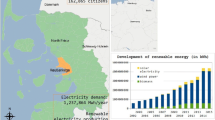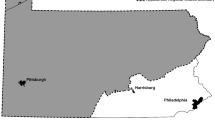Abstract
The need to decrease dependency on fossil fuels has never been more evident. Wind and solar energy sources offer promise, but siting can present obstacles. While resistance to wind and massive solar projects has, to some extent, been explored, larger, residential, ground-mounted solar projects, requiring many acres of land, and largely dependent on the receptivity of a local community for successful adoption, have largely been left unexamined. This case study explores the resistance of residents in one suburban, New England town, to a large-scale (2 MW), ground-mounted solar project in a residential neighborhood. The case study incorporates a mixed methodology of participant observation, interview, content analysis, social media activism, and participatory action research. Both the centralized nature of large scale residential solar projects, nonlocal financiers and beneficiaries, and the desire to keep residential areas esthetically pleasing and properly zoned, fueled opposition to this solar project. This research indicates that environmental advocates and policymakers need to more fully incorporate both the meanings of, and connections to places, residents of a community hold. Incentives intended to increase solar projects should not be at the expense of procedural justice, and the push should not feed solar into the centralized system, but should be in the hands of local communities in order for them to be embraced. Additionally, this case further highlights the complexity of NIMBY thinking in renewable projects. Dismissing all renewable opposition as NIMBY is failing to see the complicated nature of residents’ motivations and understandings of place. Future research exploring the success of decentralized projects, community based projects, and projects incorporated within industrial zoning is necessary.
Similar content being viewed by others
Notes
Large scale solar sites is operationalized as sites proposed, in permitting, or under construction in Massachusetts anywhere from roughly 500 Kw which takes almost two acres of land to 6 MW which can cover 24 acres of land.
Author of these articles is a former Bullard Memorial Farm Association member, ancestor, and historian. Original survey documents remain in private possession of the farm. Copies were obtained, but cannot be linked.
The town passed the new solar bylaw in May of 2012.
References
Abraham M, Maney G (2012) Transforming place and belonging through action research, community practice, and public policy: comparing responses to NIMBYism. Curr Sociol 60(2):178–201
Cole L (2009) Environmental justice and entrepreneurship: pitfalls for the unwary. New Eng Law Rev 31(3):601–609
Current Status of the Solar Carve-out Program (n.d.) Mass.gov, Executive Office of Energy and Environmental Affairs. www.mass.gov/eea/energy-utilities-clean-tech/renewable-energy/solar/rps-solar-carve-out/current-status-of-the-rps-solar-carve-out-program.html. Accessed 3 June 2016
Devine-Wright P (2012) Explaining “NIMBY” objections to a power line: the role of personal, place attachment and project-related factors. Environ Behav 45(6):761–781
DeWolf M 2012a. Preserve the Bullard Farm artifacts [online]. Holliston reporter. Available from: http://www.hollistonreporter.com/article/6269/Preserve-the-Bullard-Farm-Artifacts.html. Accessed 20 June 2016
DeWolf M. 2012b. Letter: Bullard Farm damage would be permanent [online]. Holliston patch. Available from: http://patch.com/massachusetts/holliston-hopkinton/letter-bullard-farm-association-has-changed-for-the-worse. Accessed 20 June 2016
DeWolf M 2012c. Cultural resource survey of Bullard Farm planting fields [online]. Holliston reporter. Available from: http://hollistonreporter.com/article/6397/cultural-resource-survey-of-bullard-farm-planting-fields.html Accessed 20 June 2016
Ehrhardt-Martinez K, Laitner JA (2010) People-centered initiatives for increasing energy savings. American Council for an Energy-Efficient Economy, Washington, DC
Freudenburg WR, Pastor SK (1992) NIMBYs and LULUs: stalking the syndromes. J Soc Issues 48(4):39–61
Green Communities Designation and Grant Program (n.d.) [online]. Massachusetts Department of Energy Resources. Available from: http://www.mass.gov/eea/energy-utilities-clean-tech/green-communities/gc-grant-program/. Accessed 21 Jan 2016
Henning A (2008) Temporal landscapes for the public good: negotiating solar collectors among ancient remains. Soc Cult Geogr 9(1):27–40
Hubbard P (2006) NIMBY by another name: a reply to Wolsink. Trans Inst Br Geogr 31(1):92–94
Jorgenson AK (2012) Energy: analyzing fossil-fuel displacement. Nat Clim Chang 2(6):398–399
Kaswan A (2009) Greening the grid and climate justice. Environ Law 39:1143–1161
Kraft ME, Clary BB (1991) Citizen participation and NIMBY syndrome: public response to radioactive waste disposal. West Polit Q 44(2):299–328
Marotto RA (1990) Subtexts of solar: community and conservation in the solar capital. Capital Nat Social 1(5):97–118
Massachusetts Executive Office of Environmental Affairs (2010). Model as-of-right zoning bylaw: allowing use of large-scale ground-mounted solar photovoltaic installations. December 2010. Massachusetts: Department of Energy Resources
Miller AS (1979) Solar energy: to what end? Soc Altern 1(5):48–50
Mulvaney D (2013) Opening the black box of solar energy technologies: exploring tensions between innovation and environmental justice. Sci Cult 22(2):230–237
Otto A, Leibenath M (2014) The interrelation between collective identities and place concepts in local wind energy conflicts. Local Environ 19(6):660–676
Outka U (2012) Environmental justice in the renewable energy transition. J Environ Sustain Law 19(1):60–122
Popper FJ (1981) Siting LULUs. Planning, pp 12-15
Rule T (2010) Renewable energy and the neighbours. Utah Law Rev 4:1223–1278
Solar 101 Webinar. 2010. Department of energy resources. Available from: http://www.mass.gov/eea/docs/doer/green-communities/pubs-reports/solar-101-q-and-a.pdf. Accessed 16 Jan 2013
van der Horst D (2007) NIMBY or not? Exploring the relevance of location and the politics of voiced opinions in renewable energy siting controversies. Energy Policy 35:2705–2714
Village of Euclid v. Ambler Realty Co., (n.d.) 22 Ill.297 F. 307 (N.D. Ohio 1924)
Wolsink M (2000) Wind power and the NIMBY-myth: institutional capacity and the limited significance of public support. Renew Energy 21:49–64
Wolsink M (2006) Invalid theory impedes our understanding: a critique on the persistence of the language of NIMBY. Trans Inst Br Geogr 31(1):85–91
York R (2012) Do alternative energy sources displace fossil fuels? Nat Clim Chang 2(6):441–443
Acknowledgments
I would like to acknowledge the residents of the Bullard area for their commitment, participation and activism, in particular, Thom Gilbert who spent many hours reviewing and editing this and many other related documents during the journey.




